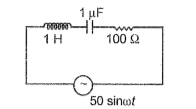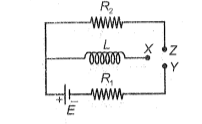The power dissipated in the following circuit will be about half of its maximum value at approximately


An ac source of emf e=50 sin 100 is connected across a circuit for which the phasor diagram is shown in the figure. The time difference between current and voltage applied across the circuit is

1. 1.25 ms
2. 1.33 ms
3. 1.67 ms
4. 1.85 ms
The instantaneous values of current (in ampere) and potential (in volt) in an A.C. circuit are I= 4 sin and V=100cos respectively. The power factor of the circuit is
In the given A.C. circuit, the instantaneous current through inductor and capacitor are 0.8 A and 0.4 A respectively. The instantaneous current through the resistor is

1. 1.2 A
2. 0.6 a
3. 0.4 A
4. A
In the LCR series A.C. circuit, as we vary the frequency of A.C. source, peak current is obtained. The value of this peak current, apart from the supply voltage, depends upon (symbols have their usual meaning)
1. L and R
2. L and C
3. R and C
4. R only
A direct current of \(2~\text{A}\) and an alternating current having peak value \(2~\text{A}\) flow through two identical resistance at the same time. The ratio of heat produced in the two resistance will be:
1. \(1:1\)
2. \(1:2\)
3. \(2:1\)
4. \(4:1\)
The inductive reactance and resistance of the L-R circuit are respectively 30 ohm and 40 ohm. The impedance of the circuit is
1. 50 ohm
2. 10 ohm
3. 70 ohm
4. ohm
A bulb and a capacitor are in series with an A.C. source. On increasing frequency, how will the glow of the bulb change?
1. The glow decreases
2. The glow increases
3. The glow remains the same
4. The glow first decreases then increases
In the circuit shown, X is joining to Y for a long time, and then X is joined to Z. The total heat produced in is ( symbols have their usual meaning)

A transformer has a turn ratio of 1: 5. A DC source of EMF 10 V is applied across its primary. EMF across the secondary will be
1. 50 V
2. 2 V
3. zero
4. 100 V
